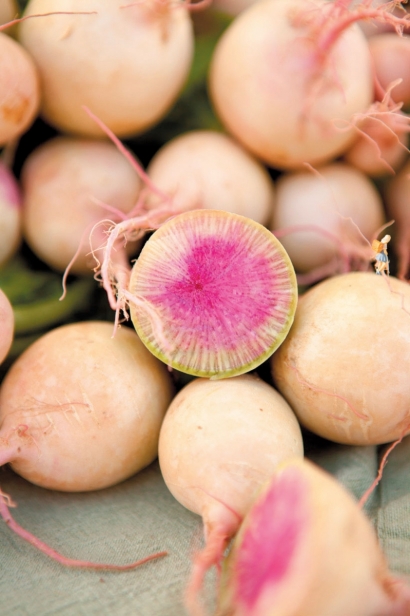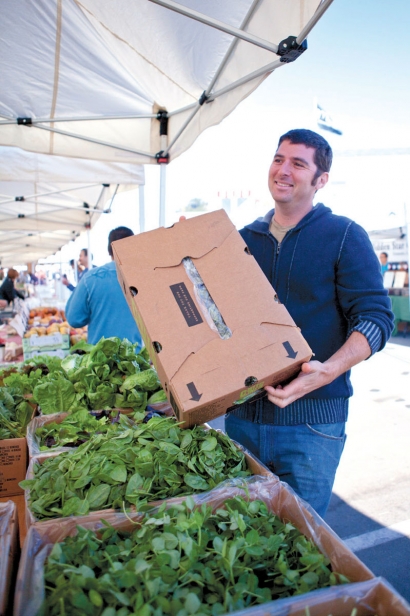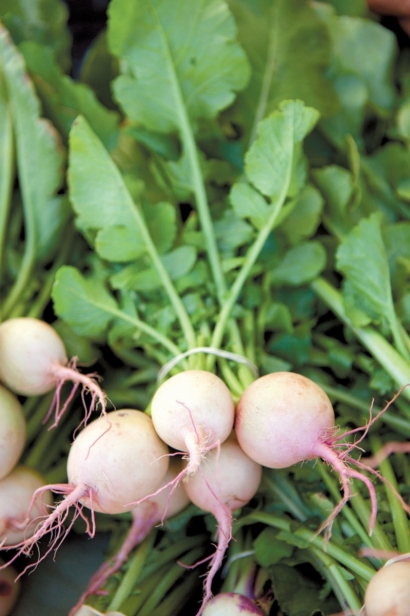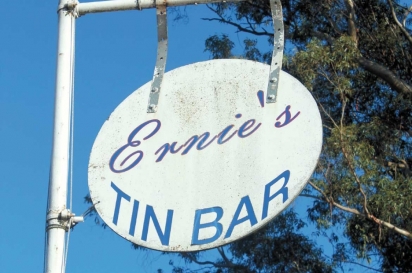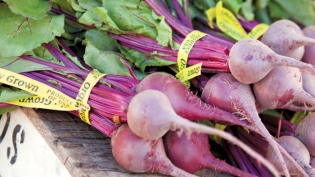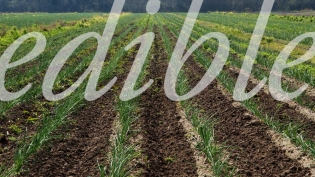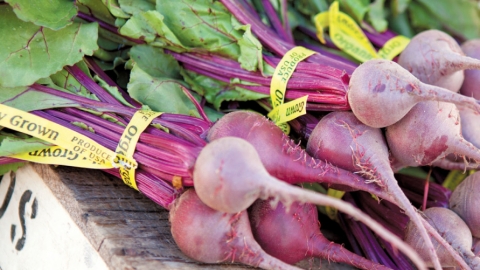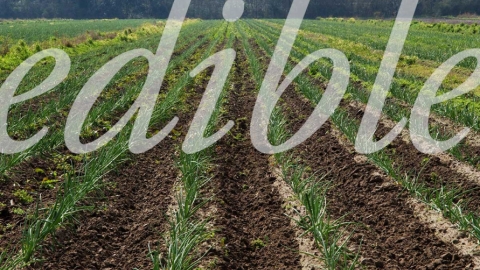Keeping it Bright and Fresh: In Search of Winter Vegetable Inspiration
Winter crops are the under appreciated superheroes of the garden. Parsnips, carrots, chard and kale ... radishes, cabbage, collards, potatoes, onions and beets! These are all powerful plants.
They are hardy. They have adapted to the most difficult conditions, armoring themselves with sturdy skin, leaves and stalks to withstand harrowing weather through months of minimum sunlight. These warrior vegetables ride out the floods and the freezes and, in the end, they offer us their extraordinary nutrients and flavor. Plus, they don’t concern themselves much with how they look, which makes them all the more intriguing and uniquely beautiful.
That said, it can be a little tricky to stay cheerful in January when it is dark at 4:45pm as you pick up your CSA box. The box is heavy, and you get that sinking feeling that when you lift the lid it will contain the exact same assortment—potatoes, onions, chard, collards, kale and beets—as it did the previous umpteen weeks.
We are spoiled here in California. Our expectations for color, playfulness and cheer in each and every day are very high. A few months without our bright tomatoes and showy late-summer peaches and we wilt. A week of slow-cooked root vegetable stew from the Crock-Pot never even occurs to us.
So, how do we ward off mid-winter moping? What do we do to cheer up our plates? Being Californians, we know that attitude is everything, and when we are feeling less than inspired by what is presented to us, we must and can spring in action to coax out the best—the color, the flavor, the curb appeal—of the highly capable, if a bit rough around the edges, locally grown cold-season vegetables.
Who better to turn to for tips on how to reignite a passion for local winter produce than local chefs who scrupulously follow the seasons, choosing not to literally chase the sun in a search for ingredients. Dan Baker is the heralded chef and owner of Marché aux Fleurs in Ross. Baker cooks, and has always cooked, precisely what is available at local markets each season. Twelve years ago Dan and his wife, Holly, opened the Provence-inspired restaurant, where Dan plans the menus, makes several runs a week to local farmers’ markets and cooks while Holly serves as pastry chef, sommelier and manages the front of the house.
“Well, yeah, sometimes when its cold and raining at the market in the middle of winter, and very few vendors are out, it can be a little bit hard to stay excited,” he admits.
I am following Baker around the Saturday Marin Country Mart farmers’ market in Larkspur, peppering him with questions. Loyal diners rave about his meals, year-round, and I am hopeful that he will provide some inspiration for how to keep things lively when the winter produce doldrums set in.
“I really am pretty excited about every season,” Baker tells me as we meander and peruse the bounty at each farm stand. “But in winter you have to look for ways to keep things fresh and bright.”
Stopping at the booths of Bloomfield Farms, Capay Valley Farms and County Line Harvest, Baker plans his menu. We ogle the towering displays of leeks and kale, potatoes and chard, and play a little game: I toss Baker names of winter vegetables, challenging him to come back with “fresh and bright” recipes.
“Kale? Yeah, kale is everyone’s favorite these days, and definitely a little overdone,” Baker says. I am listening for disdain or weariness in his responses, but that is the closest he will come to dissing a vegetable. He quickly tosses back a favorite recipe for kale. “I make a salad with shredded kale, watermelon radish, yellow beets and Parmesan crisps, with a honey champagne vinaigrette with chile and lemon.” Round one and I am already inspired.
We stop to admire a pyramid of watermelon radishes, a root Baker describes as “beautiful and versatile.” He lifts a radish that is cut in half to reveal the tie-dye-pink candy-colored interior, and tells me that he tends to roast and grill them throughout the winter. Like the light strings of the holiday season, these bulbous, pastel-colored root vegetables add cheer and remind us of the array of colors that will be back on our plates soon enough. We amble on as Baker sings the praises of his favorite off-the-beaten track salad greens: purslane and chicory. Then we stop to talk beets. Here is where I personally run out of patience in the winter. Beets, larger and more deeply purple with each passing month, just keep coming, weighing down my CSA box. Despite the fact that they are packed with antioxidants and bursting with flavor, by mid-winter I’ve almost given up. From my perspective (and my family seems to agree), there are never enough tasty ways to incorporate beets on the dinner plate.
But Baker does not miss a beat in suggesting a red, gold, pink and white roasted beet salad with fennel, mandarin oranges and pistachio vinaigrette. He cannot be beat at this coldseason crop game.
I can already feel my affection returning as I look at the wintertime market displays through Baker’s eyes. I am drawn to bunches of yellow carrots, each one more twisted and sculptural than the next, and a bushel of yellow and red onions. Creativity is certainly the key to winter cooking “a la California,” but, in the end, one of Baker’s favorite dishes takes a traditional tack utilizing some of the usual winter suspects: short ribs, braised and roasted, with carrots, celery, garlic, onions, thyme and bay are a specialty of the Marché aux Fleurs kitchen.
“Remember: Because these are the vegetables that grow in the cold season, they are sturdy enough to hold their form,” Baker says. “They are really meant to be braised and roasted and cooked over time.” Baker’s short ribs are said to melt in your mouth. Of course there is really only one way to make that happen: slowly.
A few days after visiting the market with Baker, I receive a call from my friend Anne. I tell her about my search for winter produce inspiration, and she says that she would like to help, as well. Giving me an address on Lakeville Highway in Petaluma, she invites me to join her and some friends for a drink at Ernie’s Tin Bar, guaranteeing that I won’t regret it. Drinking is one tried and true way to make it through the darkest days of winter, but I suspect there is more to Anne’s plan than simply drowning our sorrows.
That evening, as the sun drops over the foothills to the west, I drive out Lakeville Highway along the Petaluma River until I see a small building at the intersection of Lakeville Highway and Old Stage Gulch Road. Ernie’s Tin Bar is pretty much as advertised: a historic roadside bar with a corrugated tin roof that looks like it has seen a whole lot of local history unfold. As I park, a biker in full leather pulls his Harley up next to my car. He seems to know where he’s going, so I follow him in under the “Beer, Soda, Etc.” sign.
Inside, the mood is a festive mix of old-time roadside dive bar, mounted buck heads and all, and hipster, organic ale drinking establishment. I look around—taking note of a large sign proclaiming “Use a cell phone, buy a round”— and see Anne and a group of friends who have settled into some tables at one end of the bar. They’ve got pints of beer, shining amber in the last sunlight, big smiles and, at their feet, or next to them on the table, cardboard boxes.
“This is where we come to get our CSA boxes!” says Anne. “Let me introduce you to Ernie.”
Ernie Altenreuther’s family has owned this bar since 1923, as well as the dairy farm up the hill on Stage Gulch Road, which they purchased in 1908. In 1999, when Ernie Jr. was 21, he took over the bar and simultaneously took up the study of sustainable, pesticideand herbicide-free agriculture. Over the past decade and a half, he has planted the family fields with a diversity of seasonal crops, brought in 200 laying hens and transformed Tolay Valley Farm into a year-round CSA farm.
And, really, what better place to pick up your box of veggies than a bar?
It turns out Anne and company have made a ritual of retrieving their boxes, communing over a pint of “A Lil Sumpin’ Sumpin’ Ale” (one of Ernie’s featured ales from local Petaluma brewery Lagunitas Brewing Company), and then taking their bounty of produce home to cook together. A group of vegetarians, they remain notably cheerful and upbeat around all kinds of vegetables, no matter the season. They have never seen a CSA box they didn’t like, Anne tells me.
I tag along for the evening and enjoy a lovely meal featuring a winter frittata made with Tolay Valley eggs, potatoes, chard, kale, leeks, onion, garlic and feta cheese. A platter of roasted root vegetables and bread from another Petaluma favorite, Della Fattoria (also available through the Tolay Valley Farms CSA), round out the meal.
“Winter is my favorite time to pick up our CSA box,” says Anne, whose positive attitude is downright contagious. “This is when I most appreciate cooking together.”
Privately I vow to look at the bright side, no matter the season. And with that, we toast the rich Sonoma soil and Ernie’s Tin Bar for bringing us all together for this cozy January meal.
Marché Aux Fleurs, MarcheAuxFleursRestaurant.com
Tolay Valley Farms CSA, TolayValleyFarms.com/category/in-the-box



